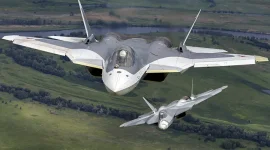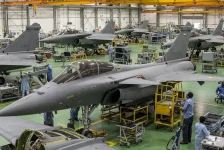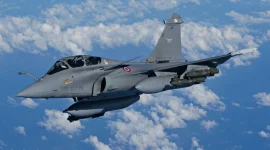- Views: 4K
- Replies: 20
The Indian Air Force (IAF) is currently facing a significant gap in its fighter squadron strength and is actively seeking solutions through its Multi-Role Fighter Aircraft (MRFA) procurement process. Amidst this search, Russia's Sukhoi Su-57 stealth fighter has emerged as a noteworthy option.
Recent advancements in Russian manufacturing capabilities and engine technology, combined with a substantial proposal for joint production in India, present the Su-57E (the export variant) as a potential interim aircraft until India's own Advanced Medium Combat Aircraft (AMCA) becomes operational, expected around the mid-2030s.
However, significant obstacles remain. Concerns surrounding the readiness of the Su-57's advanced AL-51 engine, the lack of a clear payment system for such a large-scale defence deal, and the looming threat of sanctions under the United States' Countering America's Adversaries Through Sanctions Act (CAATSA) could hinder this potential acquisition. These factors raise important questions about whether the Su-57 truly meets India's requirements for a fifth-generation fighter.
Reports indicate that Russia is substantially increasing its production rate for the Su-57, a twin-engine stealth fighter developed through the PAK FA program. Information shared around the Aero India 2025 event suggests the Komsomolsk-on-Amur Aviation Plant (KnAAZ) is producing 12 Su-57 units annually, aiming to reach 20 per year by 2028. This planned expansion, requiring about two years for implementation and another for stabilization, is set to fulfill Russia's domestic order of 76 aircraft by 2028, leaving minimal backlog.
The Russian Ministry of Defence's 2019 contract for these 76 aircraft underscores a strategic effort to modernize its air capabilities, particularly following experiences in the Ukraine conflict, with potential future orders expected. A crucial element enabling this production increase is the Su-57's supply chain, which relies heavily on Russian and Chinese sources. This reduces dependency on Western components often restricted by sanctions, allowing for a relatively faster production ramp-up compared to other advanced fighter programs. As noted in some analyses, the reliance on Russian and Chinese suppliers simplifies the scaling of production.
Russia is also advancing the Su-57's capabilities by integrating unmanned combat aerial vehicles (UCAVs) for manned-unmanned teaming (MUM-T) operations, reflecting global developments in network-centric air warfare. These upgrades, alongside the aircraft's inherent stealth features, supercruise ability (sustained supersonic flight without afterburners), and modern avionics, make the export Su-57E variant a technologically advanced offering for nations like India.
A key factor enhancing the Su-57's attractiveness is the development of its next-generation AL-51 (Izdeliye 30) engine. This engine is designed to significantly improve the aircraft's performance, particularly its stealth profile and supercruise capabilities, delivering 11 tonnes of dry thrust and 17.5 tonnes with afterburners. Currently nearing the completion of its testing phase, the AL-51 is projected to enter full production by late 2025. This timeline could suit India's needs, allowing initial Su-57E deliveries with the current AL-41F-1S engine, followed by upgrades to the AL-51 engine in subsequent batches.
The AL-51 incorporates features like serrated exhaust nozzles aimed at minimising infrared and radar detection. This directly addresses some earlier concerns the IAF had regarding the Su-57's stealth characteristics, which contributed to India's decision to leave the joint Fifth-Generation Fighter Aircraft (FGFA) program back in 2018. A representative from Rostec, Russia's state defence conglomerate, acknowledged at Aero India 2025 that while the AL-51 isn't ready for immediate export, it could be offered once its production matures, potentially bringing the Su-57E closer to India's expectations for a fifth-generation platform.
At Aero India 2025, Russia's defence export agency, Rosoboronexport, and the United Aircraft Corporation (UAC) presented an offer extending beyond simple aircraft sales. They proposed jointly producing the Su-57E at Hindustan Aeronautics Limited's (HAL) facility in Nashik, which already handles the assembly of the IAF's Su-30MKI fleet. The deal reportedly includes a full Transfer of Technology (ToT), enabling India to integrate its own systems, such as domestically developed AESA radars, avionics, and weapons, aligning with the government's 'Make in India' and 'Atmanirbhar Bharat' (self-reliant India) initiatives. This adaptability could allow India to incorporate technologies developed for its indigenous AMCA program into the Su-57E platform.
The IAF's extensive experience operating and maintaining the Su-30MKI, including local assembly by HAL and production of its AL-31FP engines, provides a significant advantage. This existing infrastructure and technical expertise could allow India to absorb Su-57 technology relatively quickly, potentially leading to faster delivery timelines compared to other MRFA contenders. Producing competitors like the Dassault Rafale locally, while favoured by some within the IAF, would likely involve higher costs.
Despite the compelling offer, substantial challenges persist. The threat of US CAATSA sanctions remains a major concern. India's previous S-400 air defence system deal with Russia encountered payment difficulties due to Western sanctions, and a clear, robust mechanism to handle the multi-billion dollar cost of a potential Su-57 acquisition is not currently in place. While some anticipate a potential easing of US-Russia relations, the risk associated with major defence deals with Russia remains significant.
Furthermore, the Su-57E faces stiff competition within the IAF's MRFA tender for 114 aircraft, which emphasizes local manufacturing. Other contenders include the Rafale, Lockheed Martin's F-21 (an India-specific F-16 variant), Boeing's F/A-18 Super Hornet, and the Eurofighter Typhoon. The IAF reportedly shows a preference for the Rafale, building on its existing fleet and operational experience. Russia's preference for a direct government-to-government (G2G) agreement, potentially bypassing the competitive MRFA process, could also complicate negotiations.
Ultimately, a critical question remains: does the Su-57E, even with future upgrades, fully meet the IAF's stringent criteria for a fifth-generation fighter? These typically include very high levels of stealth, internal weapons carriage, and supercruise capability. While the Su-57 possesses stealth features, it is generally considered less stealthy than aircraft like the US F-35. The delays in the AL-51 engine's production cast doubt on the immediate availability of full supercruise performance.
India's past withdrawal from the FGFA program cited performance issues, and recent comments attributed to a senior IAF official suggest the fully capable Su-57E (with AL-51 engines) is still several years away. This ongoing uncertainty fuels debate about whether the aircraft truly qualifies as a fifth-generation fighter according to the IAF's specific standards.




